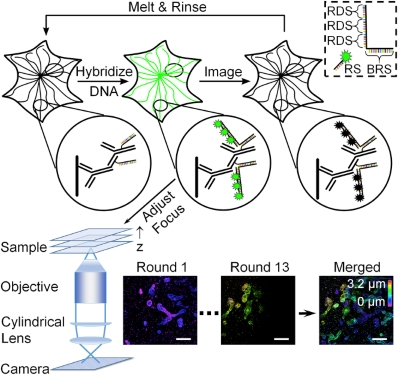Stochastic Optical Reconstruction Microscopy (STORM) Service
Creative Biostructure provides a stochastic optical reconstruction microscopy (STORM) service for exploring cellular and molecular structures with unprecedented resolution. This technique overcomes the diffraction limit of conventional optical microscopy, enabling imaging at the nanoscale.
What Is Stochastic Optical Reconstruction Microscopy (STORM)?
Observation nanoscale organization of cells is critical to understanding cell function. Due to the presence of light diffraction phenomenon, the resolution of conventional fluorescence microscopy is around 250 nm. STORM is a type of super-resolution microscope that provides more than 10 times higher resolution compared to conventional optical microscopes.
The STORM technique uses an organic fluorescent molecule-to-dye that causes a small portion of the fluorescent molecules within the cell to glow first. Each halo can be approximated as a single fluorescent molecule because the distribution of luminescent spots is more spread out and overlaps less. In one excitation, the center of one part of the halo can be determined, and in the next excitation, the center of another part of the halo can be determined. The results of multiple excitations are superimposed to obtain a complete and clear image.
 Figure 1. Workflow for prSTORM. (Lin D, et al., 2018)
Figure 1. Workflow for prSTORM. (Lin D, et al., 2018)
STORM is capable of imaging in 2D, 3D, multiple colors, and even live cells. This technology breaks through the diffraction limit of optical microscopy and can be used for single-molecule localization and counting of biomolecules, subcellular and supramolecular structure analysis, and biomolecule dynamics at a resolution scale of 20 nm.
What Can We Offer?
- 3D stochastic optical reconstruction technology
- High-precision real-time cell locking technology
- Multi-channel simultaneous imaging technology
- Nano-scale observation accuracy
- High stability
- Widely applicable
- Rapid imaging
Our Workflow for STORM
- Sample Preparation: The process begins with sample preparation. Specific fluorescent dyes or fluorophores are used to label the target molecules of interest. These labels should be compatible with the STORM imaging setup.
- Imaging: The labeled sample is illuminated with a laser source. However, the key to STORM's super-resolution capabilities is in its controlled activation and deactivation of fluorophores. By selectively turning some fluorophores on and off, only a small, sparse subset of them emits fluorescence at any given moment.
- Data Acquisition: The emitted fluorescence is captured using a sensitive camera, allowing precise localization of individual activated fluorophores. This process is repeated numerous times to build up a detailed image.
- Image Reconstruction: Complex algorithms are employed to analyze the collected data and construct a super-resolved image, revealing the intricate nanoscale structures of the sample.
Why Choose Creative Biostructure's STORM Service?
- Expertise: Our team of experienced scientists and technicians are well-versed in STORM imaging and are equipped to handle diverse projects.
- State-of-the-Art Equipment: We utilize cutting-edge STORM imaging systems, ensuring the highest quality data and superior resolution.
- Customization: We tailor our services to meet your specific research needs, from sample preparation to data analysis.
- Timely Delivery: We understand the value of time in research, and our commitment to punctuality ensures that you receive your results promptly.
- Quality Assurance: Rigorous quality control and validation protocols are implemented to guarantee the reliability of our results.
Creative Biostructure provides sample preparation, high-resolution imaging, and data analysis for samples related to cellular mitochondria, nucleus, microtubule proteins, microfilaments, Golgi apparatus, lysosomal markers, endoplasmic reticulum, actin, and more. Please contact us for more information.
Ordering Process
Reference
- Lin D, et al. Extended-depth 3D super-resolution imaging using probe-refresh STORM. Biophysical Journal. 2018, 114(8): 1980-1987.

